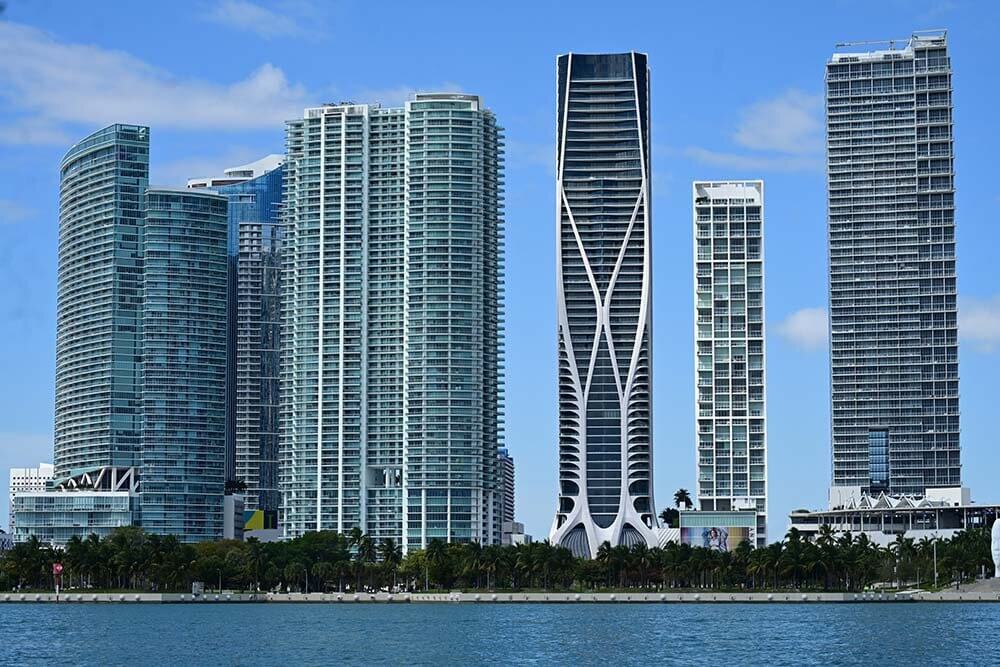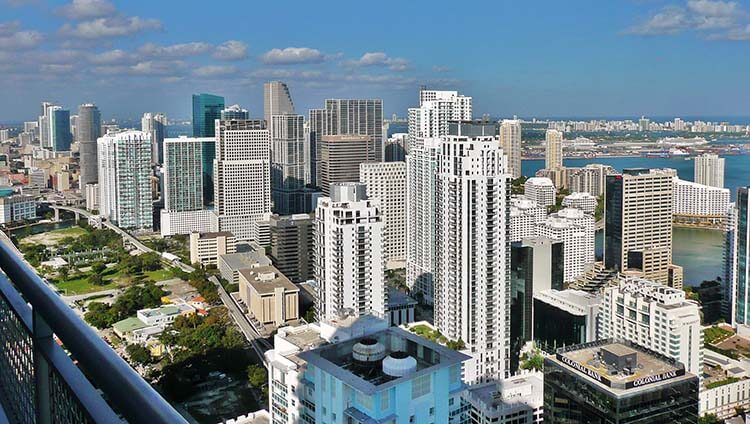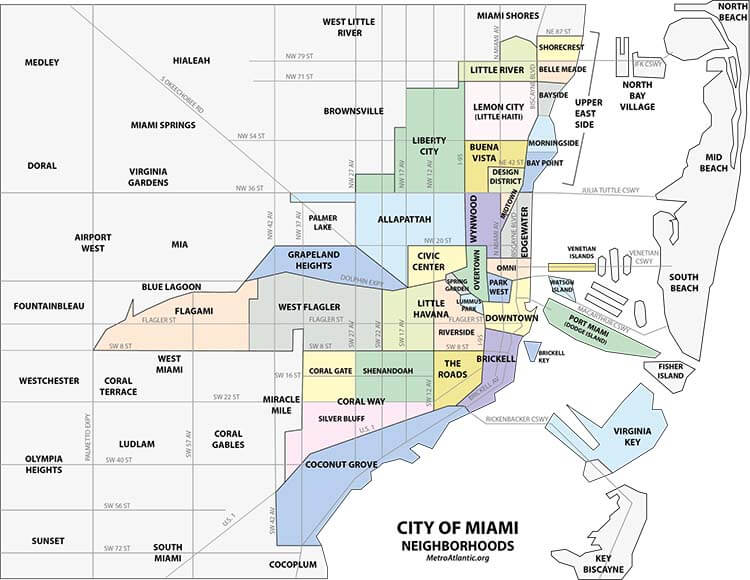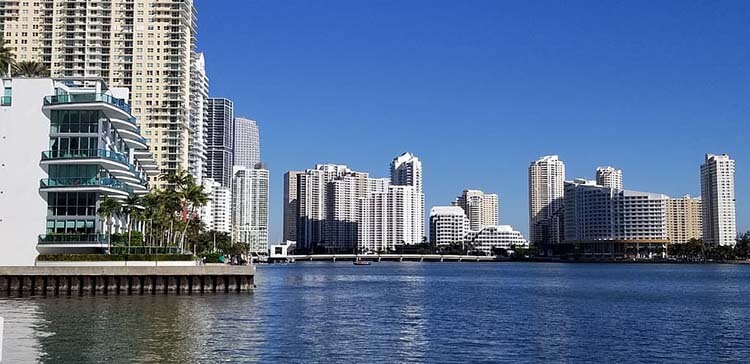The city of Miami is known for its beautiful weather, beaches, and vibrant nightlife. However, the skyline of Brickell in downtown Miami has become a symbol of the city’s growth and development over the years.
With more than 70 buildings towering above the streets, this bustling area has seen significant changes since its humble beginnings. According to the Downtown Development Authority research, Brickell’s skyline has grown exponentially since the early 2000s.
It is now considered one of the densest urban areas in America, with an average population density of approximately 36,000 people per square mile.
This impressive statistic highlights how much this once-overlooked neighborhood has transformed into a thriving metropolis that attracts business professionals and tourists worldwide.
By examining Brickell’s skyline’s history and evolution, we can understand how this small waterfront community developed into a hub for commerce, entertainment, and luxury living.
Earliest Inhabitants Of Brickell
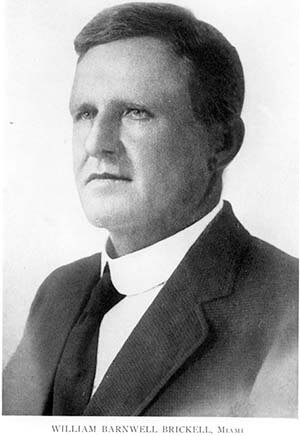 Brickell, a bustling and vibrant neighborhood in the heart of Miami, has a rich history that dates back thousands of years.
Brickell, a bustling and vibrant neighborhood in the heart of Miami, has a rich history that dates back thousands of years.
The earliest inhabitants of Brickell were the Tequesta Indians who lived along the shores of Biscayne Bay. They were skilled fishermen and hunters relying heavily on the abundant marine life in these waters.
The Tequesta Indians inhabited this area for centuries before Europeans arrived in Florida in the 16th century.
It was in the mid-1800s that urban development began to take shape in what is now known as Brickell. At this time, William and Mary Brickell purchased large tracts of land here with plans to develop it into a thriving community.
Despite their ambitious plans, it was not until after their deaths that the true potential of Brickell was realized.
Over time, the Brickell family’s legacy would become synonymous with this dynamic neighborhood, which continues to thrive today as one of Miami’s most sought-after destinations for living, working, and playing.
The Brickell Family And Their Legacy
One interesting fact about the development of Brickell’s skyline is that it owes its origins to a single-family – The Brickell.
William and Mary Brickell were early inhabitants of Miami, having come down from Cleveland in 1870 with their children.
They quickly became involved in real estate, purchasing large tracts of land south of the Miami River.
Over time, their holdings grew exponentially, making them one of the wealthiest families in South Florida.
Their legacy can still be seen today through numerous landmarks, such as the historic landmark ‘Brickell Avenue Bridge,’ built by James Egan & Sons Company in 1929 utilizing funds donated by William and Mary Brickell.
This bridge connected downtown Miami to Coconut Grove, allowing commerce between the two areas to flourish.
Their influence on modern-day Brickell cannot be overstated.
While they may have started as humble homesteaders, their savvy business sense allowed them to become instrumental players in shaping what would eventually become one of Miami’s most luxurious neighborhoods.
From establishing trading posts along Biscayne Bay to laying out roadways across untamed swamplands, the Brickells’ impact on this region has been immeasurable.
In the following section, we will explore how skyscrapers changed the face of Brickell during the Skyscraper Era.
The Era of Skyscrapers in Brickell

The Skyscraper Era in Brickell is characterized by the construction of high-rise buildings that transformed the area into a hub of commercial and residential activity.
This development was driven by Miami’s growth as a global city, attracting investors who recognized its strategic location and economic potential.
The downtown Miami skyline began to take shape with the construction of iconic structures such as the Four Seasons Hotel, which opened in 2003.
Brickell became an attractive destination for real estate developers due to its proximity to downtown Miami, the Port of Miami, and major transportation arteries. As a result, several notable skyscrapers were built throughout the district during this period.
One of these is the Infinity at Brickell Tower, completed in 2008, which stands 630 feet tall and has become one of the most recognizable landmarks in the area. Other significant developments include Icon Brickell, Axis at Brickell Village, and SLS Lux.
The Skyscraper Era was crucial in shaping Brickell’s urban landscape over time. It added to Miami’s impressive skyline and boosted local business opportunities while providing new housing options for residents.
With continued investment and innovation in urban design practices, it is clear that Brickell will remain an essential player in Dade County’s ongoing development efforts.
Urban Development In Dade County

During the Skyscraper Era in Brickell, Miami experienced a significant transformation in its skyline. The construction of high-rise buildings was driven by several factors, including expanding the railroad system and increasing demand for office space in the city’s business district.
As a result, developers started building taller buildings to maximize their land use and create more rentable spaces.
The urban development in Dade County also played a critical role in shaping Brickell’s skyline. With the growing population and economic growth, local officials invested heavily in infrastructure projects such as highways and airports.
This increased accessibility to downtown Miami from surrounding areas, attracting more businesses and residents. Consequently, a surge in demand for commercial real estate fueled the construction of skyscrapers.
As Miami grew into an important financial center during this period, many multinational corporations sought prime real estate locations within the city limits.
This trend prompted developers to build even more massive structures with state-of-the-art facilities that could accommodate these firms’ unique needs.
Some of these iconic buildings still stand tall over Brickell Avenue, symbolizing Miami’s vibrant economy and bustling metropolitan landscape.
Moving forward, Bacardi and the Cuban exile community will indelibly impact Brickell’s identity as they continue to shape its cultural heritage through various endeavors like art installations or public events to preserve Cuba’s rich history and foster new connections between locals and visitors alike.
Bacardi And The Cuban Exile Community
Bacardi, a family-owned spirits company established in Cuba in 1862, played a significant role not only in the history of Miami but also in the lives of Cuban exiles.
After Fidel Castro’s rise to power and subsequent nationalization of businesses, Bacardi was among the companies whose assets were seized by the government.
As a result, many Bacardi employees fled Cuba and found their way to Miami.
The Bacardi building, located at 2100 Biscayne Boulevard, is an iconic piece of architecture that symbolizes both the city’s skyline and the resilience of its Cuban exile community.
The construction boom that followed World War II brought high-rise buildings like those in downtown Miami today.
In particular, Brickell Avenue became a hot spot for developers who saw potential in the area’s prime waterfront location and proximity to downtown.
The Bacardi Tower was built on Biscayne Boulevard just north of downtown Miami in 1973 – designed by Enrique Gutierrez – joining other notable structures like One Biscayne Tower (1972) and Southeast Financial Center (1984).
This period marked a turning point for Brickell’s skyline as developers began constructing taller, more modernist structures.
Architects experimented with different styles during this period; some leaned towards modernism, as exemplified by I.M. Pei’s work on buildings such as the John Hancock Tower in Boston (completed in 1976).
Although Pei never worked on projects specifically within Miami or Brickell, his influence can still be felt through similar designs used throughout South Florida.
Modernist structures continued to multiply throughout Miami over time; however, they eventually made way for even newer architectural directions.
I.M. Pei And Modernist Structures
As the sun set over Miami in the 1980s, a new era of high-rise buildings began to take shape. One of the most influential architects of this time was I.M. Pei, whose modernist structures would forever change the city’s skyline.
Pei’s designs were futuristic and timeless, using sleek lines and geometric shapes. Pei’s impact on Brickell cannot be overstated. His work can be seen in iconic buildings such as the Four Seasons Hotel and Tower, which features a distinctive triangular shape that rises from its base like a blade slicing through the sky.
Another notable example is Espirito Santo Plaza, whose striking blue glass façade reflects the surrounding cityscape. Overall, Pei’s contributions to Brickell helped pave the way for future development in the area.
By embracing a bold and forward-thinking aesthetic, he inspired other designers to push boundaries and explore new possibilities for what could be achieved within an urban environment.
As we will see in the next section, these efforts have continued to bear fruit in recent years, with exciting residential and mixed-use developments taking root throughout Brickell.
Brickell’s Residential And Mixed-Use Developments
Brickell’s skyline has significantly transformed in recent years thanks to several residential towers and mixed-use developments. The area is now renowned for its luxury condos that offer unmatched views of the cityscape and waterfront.
Check out this article about the top condo buildings in Brickell for 2023, which showcase state-of-the-art amenities such as fitness centers, rooftop pools, and concierge services.
The first wave of modern-day Brickell began with two iconic buildings: the Santa Maria and Bristol Tower. Both were completed in 1997 and set a new standard for luxury living in Miami. Since then, high-rise construction has continued at an unprecedented pace, resulting in many impressive structures dotting the landscape today.
In addition to condominiums, many mixed-use developments have also been built. These buildings often house office spaces, retail stores, restaurants, or hotels on their lower levels while reserving upper floors for residential units.
As a result of all this growth and investment, Brickell has become one of Miami’s most sought-after neighborhoods. Visitors are greeted by an awe-inspiring view upon entering downtown from I-95 South – the towering skyscrapers lining both sides of Brickell Avenue make it clear that they’ve arrived somewhere special!
With so much to see and do in this bustling district (including more than 60 bars/restaurants), it’s no wonder why people flock here from around the world year after year to experience what makes Miami unique.
Here are some reasons why Brickell’s Residential Towers & Mixed-Use Developments stand out among other regions:
Excellent Location – Situated right off Biscayne Bay between Coconut Grove and Downtown Miami.
Luxurious Amenities – Rooftop Pools/Gyms/Concierge Services available
Unbeatable Views – Many upscale condos offer panoramic views of either Biscayne Bay or the Atlantic Ocean.
Excellent Investment Opportunity – High demand means good resale value and the potential for significant rental income.
Brickell is poised to continue growing as a luxury destination with haute shopping and fine dining experiences catering to a discerning clientele. The area’s increasing prominence on the global stage has put it firmly in the spotlight – some even say it’s becoming Miami’s new ‘downtown.’
With so many exciting developments (including more mixed-use projects), there’s no telling what kind of skyline we’ll look at in another decade!
Luxury Destination With Haute Shopping And Fine Dining
Brickell’s skyline has come a long way from its humble beginnings as a primarily residential area. The district transformed in the late 20th century by constructing several high-rise buildings for commercial and mixed-use purposes.
These developments have contributed significantly to Brickell’s emergence as one of Miami’s most affluent neighborhoods.
Today, luxury shopping and fine dining are synonymous with Brickell’s vibrant cityscape. High-end retailers like Saks Fifth Avenue, Valentino, and Chanel have set up shop alongside local boutiques offering unique items that cater to discerning tastes.
Similarly, restaurants such as Komodo, Zuma, and La Mar by Gastón Acurio serve elevated cuisine that draws foodies from all over South Florida.
Brickell’s retail and culinary offerings reflect the neighborhood’s status as an upscale destination. Visitors can indulge in designer fashion or enjoy Michelin-starred meals while taking in panoramic views of the city below.
Indeed, Brickell is more than just a financial hub; it has become a symbol of luxury living in Miami that continues attracting new residents and businesses.
While Brickell may be known for its luxurious amenities on land, there is another aspect of this neighborhood that makes it even more enticing – its proximity to Miami’s beautiful waterfronts.
Waterfront And Oceanfront Vacation Destination

As one gazes upon the magnificent skyline of Miami, it is hard to miss the high-rise buildings that adorn its waterfront. These towering structures are not simply a collection of condominium towers but indicate Miami’s growth and development over the past few decades.
The city has transformed from a small beach town into a bustling metropolis with a thriving economy. Miami’s status as an oceanfront vacation destination makes it even more appealing to visitors who come to bask in the sun or engage in water sports on its pristine beaches.
This attraction has led developers to construct luxurious hotels and resorts along the coastline, enticing tourists with breathtaking views and amenities.
However, these hotels have been overshadowed by several iconic residential projects, such as Brickell City Centre, which houses shopping malls, restaurants, offices, and apartments under one roof.
The combination of Miami’s stunning waterfront location and the vibrant downtown area has made it an attractive destination for investors seeking prime real estate opportunities.
As demand for luxury properties in this tropical paradise continues, we can expect further developments that will add even more glamour to the already impressive skyline.
The Future Of Brickell’s Skyline
As a waterfront and oceanfront vacation destination, Brickell has always been one of the most sought-after locations in Miami. However, it was in the 1970s that this area began to transform into a financial district with high-rise buildings dominating its skyline.
Real estate development kicked off during this era when several developers started buying properties in Brickell.
The skyscraper era of Brickell’s history saw the creation of iconic towers such as the Four Seasons Hotel & Tower, Espirito Santo Plaza, and Jade at Brickell Bay. These towering structures continue to shape and define the cityscape today.
As more investors were drawn to these high-rises, demand for real estate skyrocketed, leading to an influx of new developments.
Looking toward the future, it is evident that Brickell’s skyline will only continue to grow taller as developers rush to capitalize on this prime location.
With plans for even bigger projects like One Brickell City Centre already underway, we can expect many more impressive additions soon.
As long as people seek luxury living spaces in a thriving metropolitan hub like Miami, Brickell’s skyline will constantly evolve toward newer heights.
Frequently Asked Questions
What Is The Average Cost Of Living In Brickell, Compared To Other Neighborhoods In Miami?
Comparing the cost of living in Brickell to other neighborhoods in Miami requires careful analysis.
According to recent data, the average rent for a one-bedroom apartment in Brickell is around $2,200 monthly.
Neighborhoods like Little Havana and Allapattah offer more affordable options, with monthly rents averaging around $1,500.
However, it’s important to note that these areas may not have the same amenities and luxury lifestyle as Brickell.
When considering overall expenses such as transportation and dining out, the cost of living can vary significantly from person to person, depending on lifestyle choices.
Utilizing the rhetorical device of hyperbole highlights how significant differences between neighborhoods can be exaggerated or understated based on context and personal preference.
Are There Any Notable Cultural Or Artistic Attractions In Brickell?
Brickell is an area in Miami that boasts many cultural and artistic attractions.
One notable attraction is the Brickell City Centre, a shopping center that houses a variety of high-end retail stores and restaurants.
Another attraction is the Pérez Art Museum Miami (PAMM), which features contemporary art exhibitions from local and international artists.
Additionally, Brickell has several theaters and performance venues, including the Olympia Theater and the Adrienne Arsht Center for the Performing Arts.
These attractions offer visitors and residents an opportunity to immerse themselves in the vibrant cultural scene of Brickell.
How Has Brickell’s Skyline Been Affected By Natural Disasters, Such As Hurricanes?
Various natural disasters, including hurricanes, have impacted Brickell’s skyline.
Hurricane Andrew in 1992 caused significant damage to the area and prompted stricter building codes for future developments.
In 2017, Hurricane Irma resulted in flooding and power outages throughout Brickell, causing some buildings to evacuate residents temporarily.
However, many newer high-rise buildings were designed with hurricane-resistant features such as impact windows and reinforced concrete structures.
Additionally, ongoing efforts to improve infrastructure and drainage systems aim to mitigate the effects of future storms on Brickell’s skyline.
What Is The Percentage Of International Residents Or Investors In Brickell’s Real Estate Market?
Brickell’s real estate market has been a hub for international residents and investors, contributing significantly to the city’s growth.
The percentage of foreign buyers in Brickell is around 40%, making it one of the top areas for overseas investments in Miami.
This trend can be attributed to various factors such as favorable exchange rates, tax benefits, and an overall stable economy.
Despite the ongoing pandemic, there has been no significant downturn in foreign investment activity, indicating that Brickell remains an attractive option for global buyers seeking profitable investment returns.
How Has Brickell’s Transportation Infrastructure Evolved Over Time?
Brickell’s transportation infrastructure has undergone significant changes, transforming from a primarily car-centric area to one with increased accessibility and public transit options.
The introduction of the Metromover in 1986 provided residents and visitors with an efficient mode of transportation within Brickell. The expansion of the Metrorail system in recent years has made it easier for individuals to commute from other parts of Miami-Dade County.
Additionally, plans for a new pedestrian bridge connecting Brickell to nearby attractions such as the Underline Park are underway.
These developments reflect a growing emphasis on sustainable urban mobility and improving connectivity within Brickell.
Conclusion
Brickell’s skyline has undergone significant changes throughout its history. From a quiet suburban neighborhood to a bustling financial district, the area has experienced rapid growth and development over time.
The cost of living in Brickell is higher than other neighborhoods in Miami due to its prime location and amenities.
Despite being known for its business-focused atmosphere, Brickell boasts cultural attractions such as the Miami Museum of Contemporary Art and the Vizcaya Museum & Gardens.
However, natural disasters like hurricanes have threatened this area’s infrastructure multiple times, leading to stricter building codes and hurricane-resistant designs.
Brickell’s real estate market attracts many international investors, with up to 75% of buyers coming from overseas markets.
Sources:
https://en.wikipedia.org/wiki/Brickell
